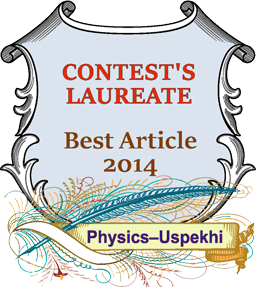 |
RSS feeds |
|
|||||
| Issue 12, 2025 |
|
||||||
|
|
|
||||||
Issues/2014/November |
← → |
| Reviews of topical problems |
Electrical cycle in the Earth’s atmosphere
Joint Institute for High Temperatures, Russian Academy of Sciences, ul. Izhorskaya 13/19, Moscow, 127412, Russian Federation

A qualitative physical picture of atmospheric electricity as a secondary phenomenon of atmospheric water circulation is presented using the key electric atmospheric processes, their average observed parameters and a detailed analysis of separate processes as the basis. The electric processes begin with the charging of aerosols at kilometer altitudes due to aerosols of different aggregate states colliding with one another. Atmospheric electric currents arise from the fall speed difference (in cumulus clouds) between mass-different positively and negatively charged aerosols, resulting in aerosols with a negative charge of, an average, (25—30)e at the lower edge of a cloud. This creates an electric field between earth and the cloud, and the subsequent penetration of streams of warm wet air into the cloud causes the atmosphere to electrically breakdown thus producing lightning strokes. At the same time, these processes cause aerosols to grow and to fall down as rain onto earth. Processes in atmospheric air, including those involving aerosols, electrons and ions, provide a unified physical picture of electric phenomena in the terrestrial atmosphere.
|
PACS: 92.60.Bh, 92.60.Mt, 92.60.Pw ()
DOI: URL: https://ufn.ru/en/articles/2014/11/a/  000349435700001 000349435700001  2-s2.0-84922723906 2-s2.0-84922723906  2014PhyU...57.1041S 2014PhyU...57.1041S Citation: Smirnov B M "Electrical cycle in the Earth's atmosphere" Phys. Usp. 57 1041–1062 (2014) Received: 20th, January 2014, revised: 28th, June 2014, accepted: 15th, July 2014 Оригинал: Смирнов Б М «Электрический цикл в земной атмосфере» УФН 184 1153–1176 (2014); |
|
© 1918–2025 Uspekhi Fizicheskikh Nauk Email: ufn@ufn.ru Editorial office contacts About the journal Terms and conditions |